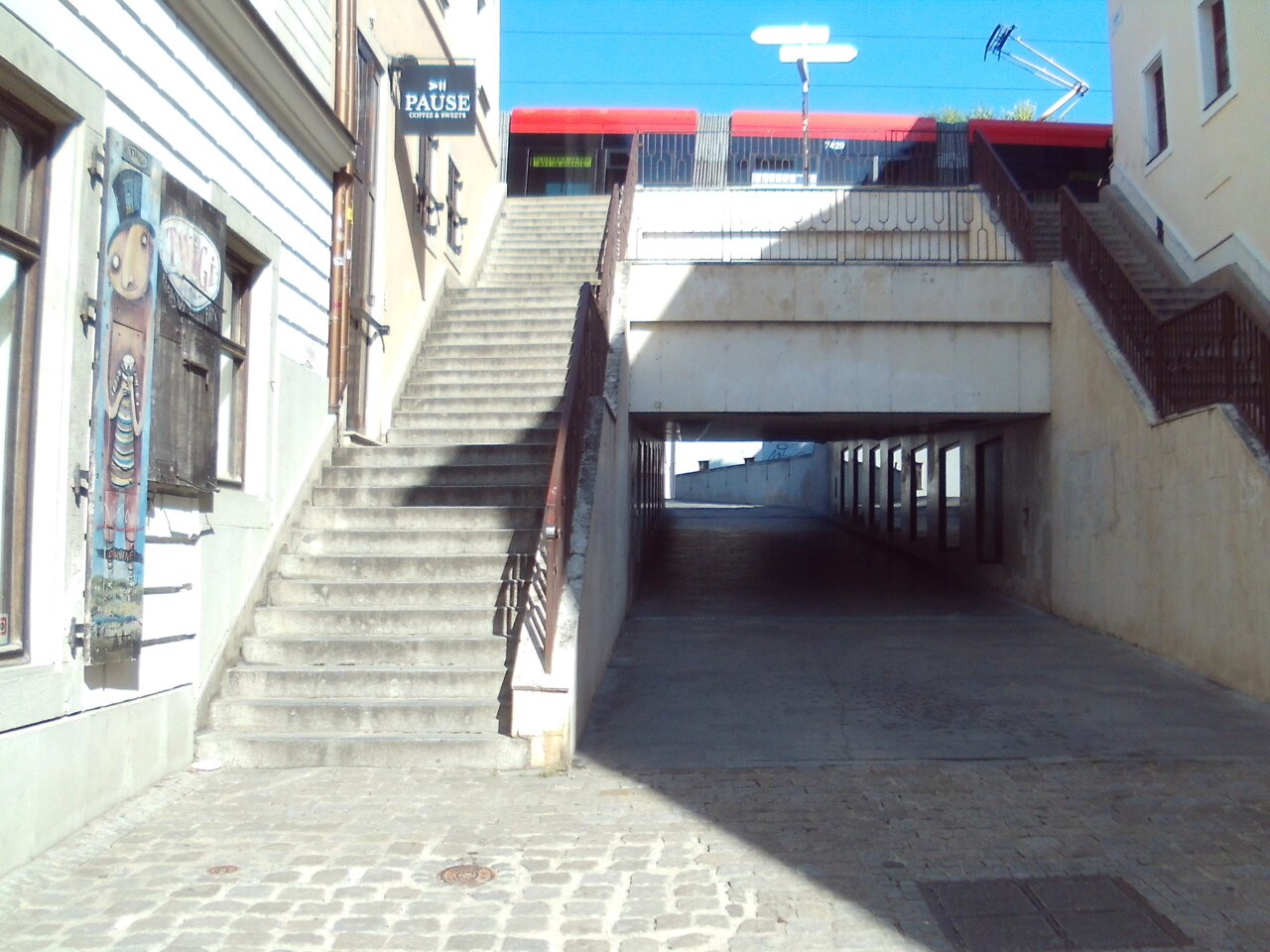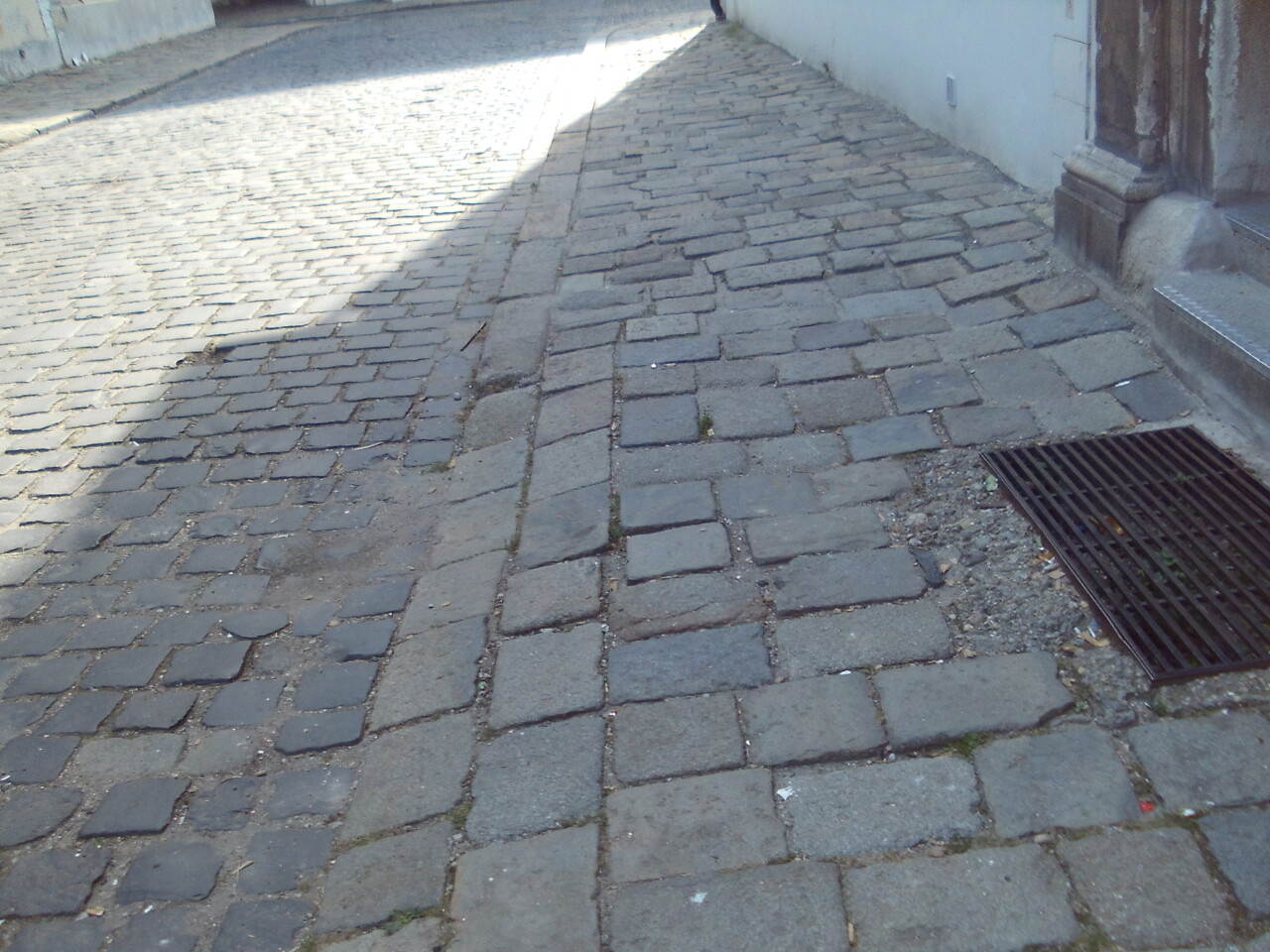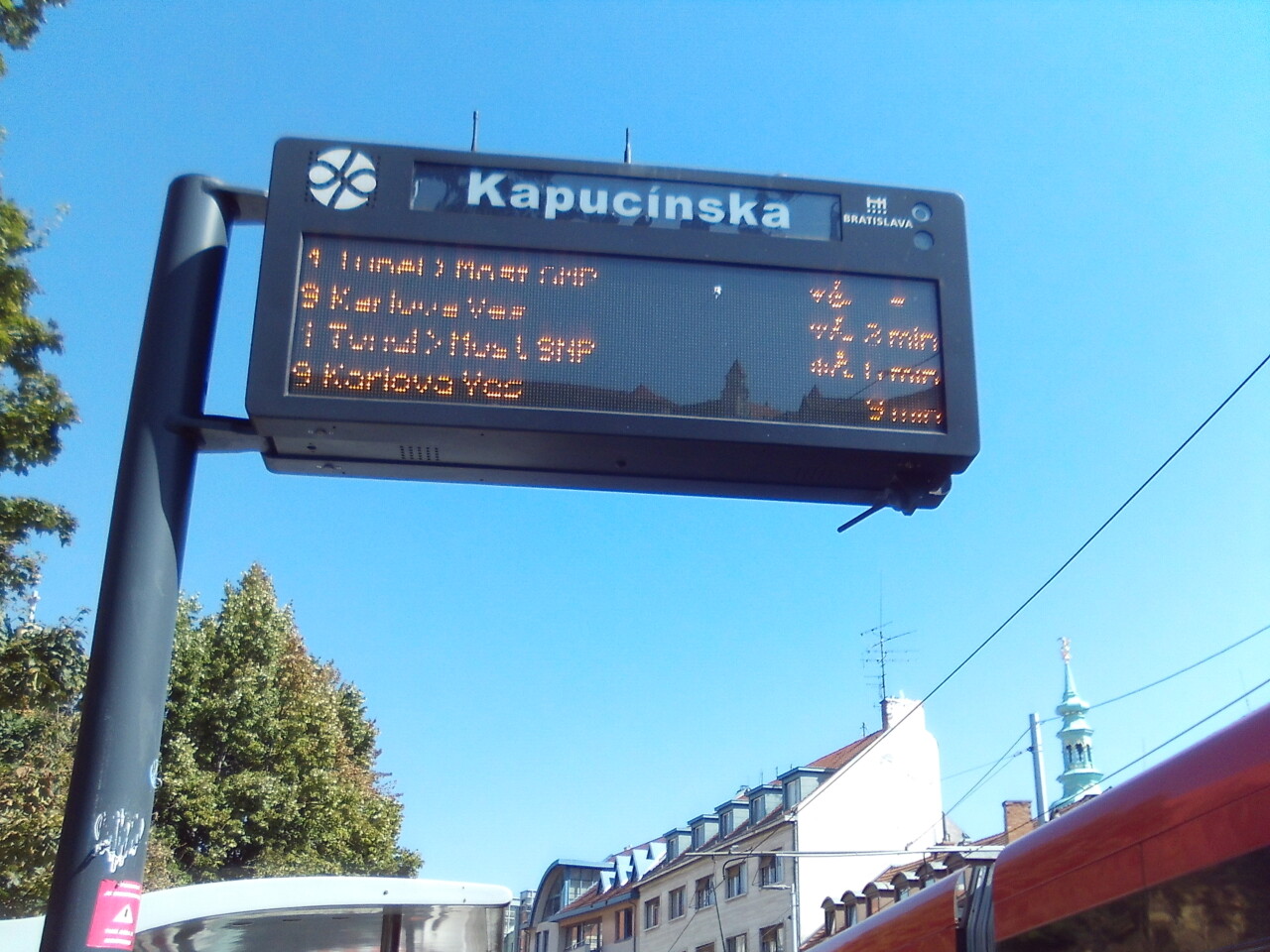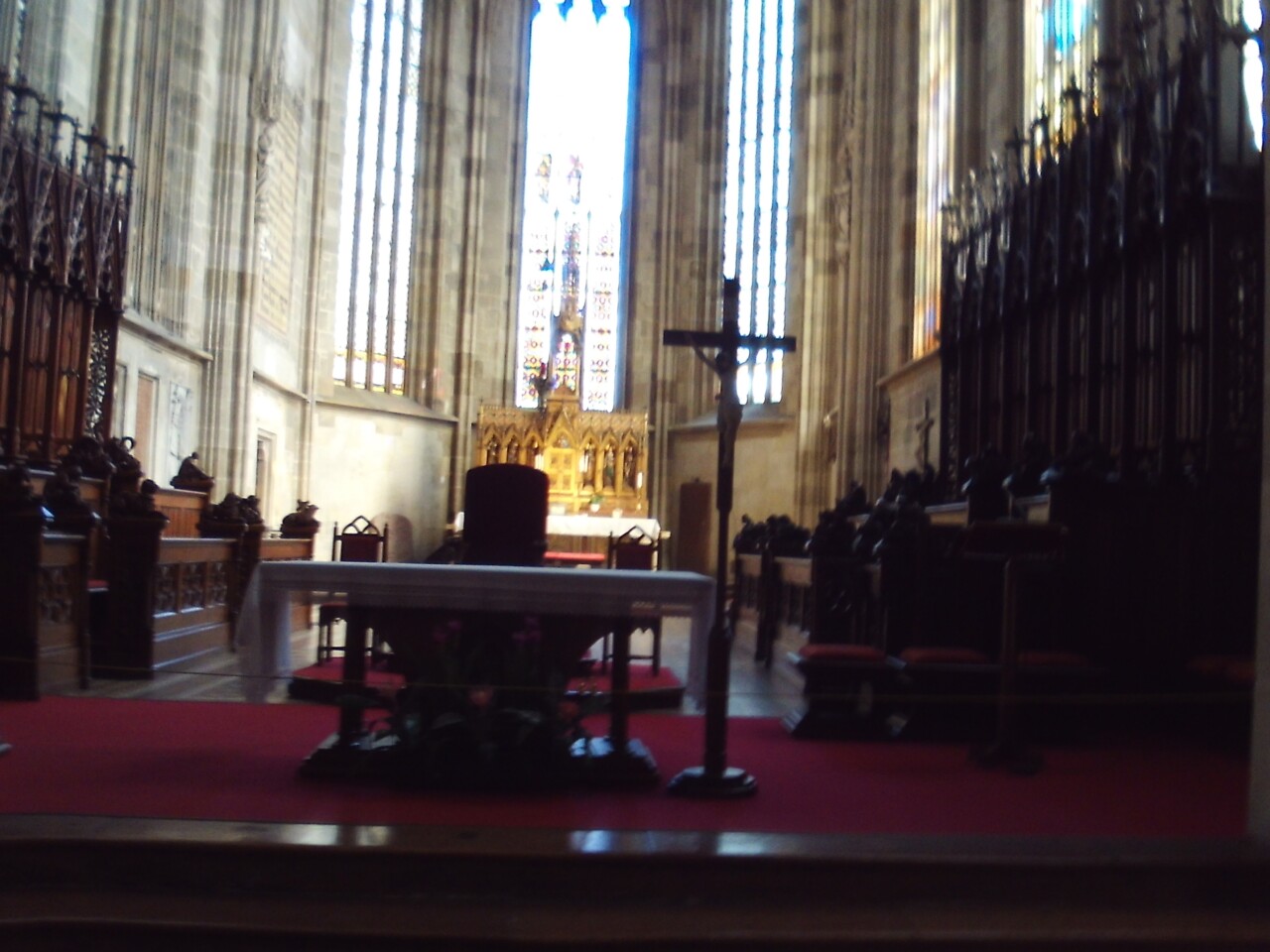I arrived in Vienna without delay by plane and from there took a Flixbus to the main bus station in Bratislava, Mlynske Nivy. The ordered taxi was already waiting for me for the last short ride to the Ibis Hotel, located near the historic centre. The room in the hotel was a bit on the small side, but it was sufficient. To enter the hotel, you have to climb a few steep steps. Or you can take the ramp, which is there for a reason, as the hotel has a special room for wheelchair users. During my short stay, a lady in a wheelchair was indeed staying there.
The accommodation where I stayed was thus okay. Of course, you don’t go on a trip to sit in your hotel room all day. You want to see something of the city. The historic centre is a five-minute walk away via the shortest route. That shortest route is a challenge, involving the descent of three large staircases (see photo at the top of the article). Fortunately, the handrails were always on the right side for me. People who can not go up or down the stairs will have to take a detour to get to the historic centre.
Damned Cobblestones Again
Once you start walking to the historic centre, it’s important to walk carefully and in control. Many streets are sloping and the pavement is abominable, as can be seen in this photo. On the main square in the centre, you suddenly walk on entirely paved ground. For ten years, after walks in so many European inner cities, I have been wondering why city governments don’t prioritize accessible paving throughout the city. I will continue to repeat the question ad nauseam.
As for Bratislava, there are plenty of people with physical disabilitie/elderly people walking and driving around in wheelchairs. They stay on their feet because they deal with it every day and are thus used to it. I also stayed on my feet, thanks to remaining focused while walking and always choosing the right stone to step on.
Public Transport in Antwerp Could Learn from Bratislava
For the interview I had in Bratislava with Stanislav Sokol of the Slovak Union of the Blind and Partially Sighted I had to take public transport. The tram stop was located near the hotel. In Bratislava, two types of trams are in operation: old ones with steps and modern ones that are entirely level. My preference, of course, went to the modern trams. But how do you know which tram is coming if both models are used on a certain line? You can tell by the screens at the stops which announce how many minutes it takes until the tram arrives. If it’s a modern tram, you’ll see a wheelchair symbol before the indicated time. It doesn’t seem too difficult to introduce this in Antwerp too on lines where both modern and old equipment are currently used.
The modern trams also have an internal screen that indicates the stops. These are also announced. So both the blind/partially sighted and deaf/hard of hearing can travel independently. ‘The blind can’t see that wheelchair symbol at the stops, can they?’ That’s true. I didn’t ask, but I suspect they can hear whether it’s an old or modern tram. And even if it’s an old one, according to Stanislav the blind don’t have much trouble with steps. What is an obstacle for one person with a disability may not be so for another.
It’s also worth mentioning that the platforms are adapted to the modern trams (equal height) and that a ticket machine is located at every stop. How much easier could it be, if you don’t have a Smartphone to buy a ticket that way? The prices are quite reasonable. For a single trip of 30 minutes within a maximum of two zones, you pay 1.10 euros.
The interview with Stanislav delves deeper into the situation of the blind and partially sighted in Bratislava and, by extension, in all of Slovakia. I hope to publish the English version with his approval later this month. The Dutch translation will follow after the English version. It is work in progress. Now, let’s take a look at what kind of city Bratislava is in general.
Bratislava’s Centre Can Be Visited in One Day
Tourists are plentiful in Bratislava. Many are German speaking, primarily from neighbouring Austria, although for Germans Bratislava is not far away as well. I also spotted several Americans, had dinner next to two Dutch couples (I deliberately didn’t speak any Dutch while sitting next to them) and there were quite a few Asians around. Tourists are real herd animals. They follow the tour guide or let themselves be driven around in special sightseeing buses. I deliberately didn’t do that this year. I had just one day to properly explore the centre. I didn’t want any pre-chewed experiences. I just wandered around.
That’s how you get to know a (part of a) city better. Street in, street out. Alley in, alley out. What kind of church is that? What kind of courtyard? Etc. I skipped the main attraction, the castle. I had already conquered so many steep streets that I didn’t feel like following another steep path to the castle, which is located on a hill. Going up is one thing; you also have to get down again. I don’t think I need to outline that going down poses a greater challenge for less mobile people than going up.
While wandering I eventually ended up at St. Martin’s Cathedral, another tourist must-see. For a cathedral, it’s actually a rather modest building. The interior doesn’t differ much from that in other cathedrals.
There are more than enough restaurants and cafes. The restaurants mainly target German speaking tourists. German is the first language on the menus, after Slovak of course. Their offerings consist mainly of Fleisch und Bier (Meat and Beer). Vegetarians like me better scrutinize the menus in advance before sitting down somewhere. Most of the time you find something to your liking. Some restaurants offer to make minor adjustments to a dish. The price level varies per restaurant, but for 20/25 euros you get a main course, dessert and a drink.
There are plenty of souvenir shops in the historic center. Be aware of the price setting! In the first one I entered for a T-shirt, as I have the habit of buying a T-shirt in some cities I visit, a T-shirt cost 36 euros. The print was hand-embedded in the fabric, but still: too expensive. In a competing souvenir shop I bought a standard manufactured T-shirt for 16 euros. It saves a nice 20 euros, which can be spent on another dinner…
One last notable fact is the presence of many addresses for Thai Massage. Within a radius of less than a kilometer, I saw signs for Thai Massage at three addresses. Whether the residents of Bratislava are preoccupied with their health or it’s a cover for more sexually oriented services, who can tell … They are all located on higher floors, and nothing more can be seen from outside the building.
No Signs of War
The reason I postponed my trip to Bratislava, and thus the end of my journey through the EU member states, for so long had everything to do with the war currently raging in neighbouring Ukraine. After spending about 54 hours in Bratislava I can confirm that there are no concrete signs of that war in Slovakia. Slovaks are just going about their daily business. I haven’t seen or heard that any special measures or ordinances are in effect. However, the war is very much on the Slovaks’ minds.
The taxi driver who drove me to the hotel on Sunday evening asked me whether Belgium also hosts Ukrainian refugees. I replied affirmatively. His next question was how much money the Ukrainians in Belgium receive as financial aid. I didn’t have an immediate concrete and exact answer. In the first few weeks after their arrival, they got free housing and pocket money. By now, many will have found some work. According to the taxi driver, the Ukrainians in his country receive 800 euros/month. Whether they have to pay for their housing out of that wasn’t clear from his story. Most Ukrainians in Slovakia have also found work by now, especially in low-skilled jobs.
I asked the taxi driver who drove me to the bus station on Wednesday morning whether the Slovaks are not afraid because of the war along their border. He confirmed that he had been afraid in the first days after it started. Not anymore at the moment. ‘We are a NATO member.’ True, and if one member is being attacked the entire NATO comes into action, and all hell breaks loose. That was one of my concerns and arguments for postponing the trip. The current Slovak government firmly supports Ukraine. Parliamentary elections will be held in the country on Saturday September 30. Campaign posters can be seen all over the city. Will the elections bring a change in course?
Bratislava Faces Early Mornings
As early as Sunday evening around 7:15 pm, it was already getting dark. The Flixbus from Vienna to Bratislava had just crossed the border. ‘Strange,’ I thought to myself. In Antwerp it’s still light until just after 8:00 pm in mid-September, and Slovakia is in the same time zone as Belgium and the Netherlands. I couldn’t think of a reason why this was the case and posed the question on X (formerly Twitter, one should add). The answer didn’t take long.
‘The sun rises in the east. It’s getting light there earlier and getting dark earlier. It’s also darker earlier in for instance Maastricht than in Vlissingen.’ I had never thought about it! Most of my trips through the EU member states were made in May. Then it will probably be less noticeable. At 6:00 am, the sun was already high in the sky in Bratislava. So, no sleeping in for me on Monday and Tuesday.
Copyright photos: Johan Peters




